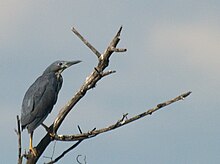Dwarf bittern Last updated February 28, 2025 Species of bird
The dwarf bittern (Botaurus sturmii heron in the family Ardeidae that is widely distributed across Sub-Saharan Africa avoiding only the very arid regions. This species was formerly placed in the genus Ixobrychus .
Distribution It is found in Angola , Benin , Botswana , Burkina Faso , Burundi , Cameroon , Central African Republic , Chad , Republic of the Congo , Democratic Republic of the Congo , Ivory Coast , Equatorial Guinea , Eswatini , Ethiopia , Gabon , Gambia , Ghana , Guinea , Kenya , Liberia , Malawi , Mali , Mauritania , Mozambique , Namibia , Niger , Nigeria , Rwanda , Senegal , Sierra Leone , Somalia , South Africa , Spain (the Canary Islands ), Sudan , Tanzania , Togo , Uganda , Zambia , and Zimbabwe . [ 1] It is a rare vagrant in the Western Palearctic (which consists of Europe, North Africa and the Middle East), with several sightings in the Canary Islands . [ 9] Two individual were observed on the island of Fuerteventura in the Canary Islands in the winter of 2017. [ 10]
Description It is a small bittern , and the same size as the little bittern , to which it is closely related.
References 1 2 3 BirdLife International. (2016). "Ixobrychus sturmii " . IUCN Red List of Threatened Species . 2016 : e.T22697327A93608515. doi : 10.2305/IUCN.UK.2016-3.RLTS.T22697327A93608515.en . Retrieved 8 August 2021 . ↑ Wagler, Johann Georg (1827). Systema Avium ↑ Jobling, James A. "sturmii" . The Key to Scientific Names . Cornell Lab of Ornithology. Retrieved 27 February 2025 . ↑ Mayr, Ernst ; Cottrell, G. William, eds. (1979). Check-List of Birds of the World 1 (2nd ed.). Cambridge, Massachusetts: Museum of Comparative Zoology. p. 241. ↑ Päckert, M.; Hering, J.; Fuchs, E.; Barthel, P.; Heim, W. (2014). "Genetic barcoding confirms first breeding record of the Yellow Bittern, Ixobrychus sinensis , (Aves: Pelecaniformes, Ardeidae) in the Western Palearctic" . Vertebrate Zoology . 64 (2): 251– 260. doi : 10.3897/vz.64.e31492 . ↑ Hruska, J.P.; Holmes, J.; Oliveros, C.; Shakya, S.; Lavretsky, P.; McCracken, K.G.; Sheldon, F.H.; Moyle, R.G. (2023). "Ultraconserved elements resolve the phylogeny and corroborate patterns of molecular rate variation in herons (Aves: Ardeidae)". Ornithology . 140 (2): ukad005. doi :10.1093/ornithology/ukad005 . ↑ Chesser, R.T.; Billerman, S.M.; Burns, K.J.; Cicero, C.; Dunn, J.L.; Hernández-Baños, B.E.; Jiménez, R.A.; Johnson, O.; Kratter, A.W.; Mason, N.A.; Rasmussen, P.C.; Remsen, J.V.J. (2024). "Sixty-fifth Supplement to the American Ornithological Society's Check-list of North American Birds" . Ornithology . 141 (3): ukae019. doi : 10.1093/ornithology/ukae019 . 1 2 Gill, Frank ; Donsker, David; Rasmussen, Pamela , eds. (August 2024). "Ibis, spoonbills, herons, Hamerkop, Shoebill, pelicans" . IOC World Bird List Version 14.2 . International Ornithologists' Union. Retrieved 27 February 2025 . ↑ Svensson, Lars (2009). "Vagrants". Collins Bird Guide (2nd ed.). HarperCollins . p. 409. ISBN 9780007268146 ↑ Kratzer, Daniel; Liundy, Vernon; Ławicki, Łukasz (January 2018). "Two Dwarf Bitterns on Fuerteventura, Canary Islands, in winter of 2017/18" . Dutch Birding . 40 (2): 98– 101. Retrieved 30 April 2020 .
Ixobrychus sturmii Ardea sturmii
This page is based on this
Wikipedia article Text is available under the
CC BY-SA 4.0 license; additional terms may apply.
Images, videos and audio are available under their respective licenses.


